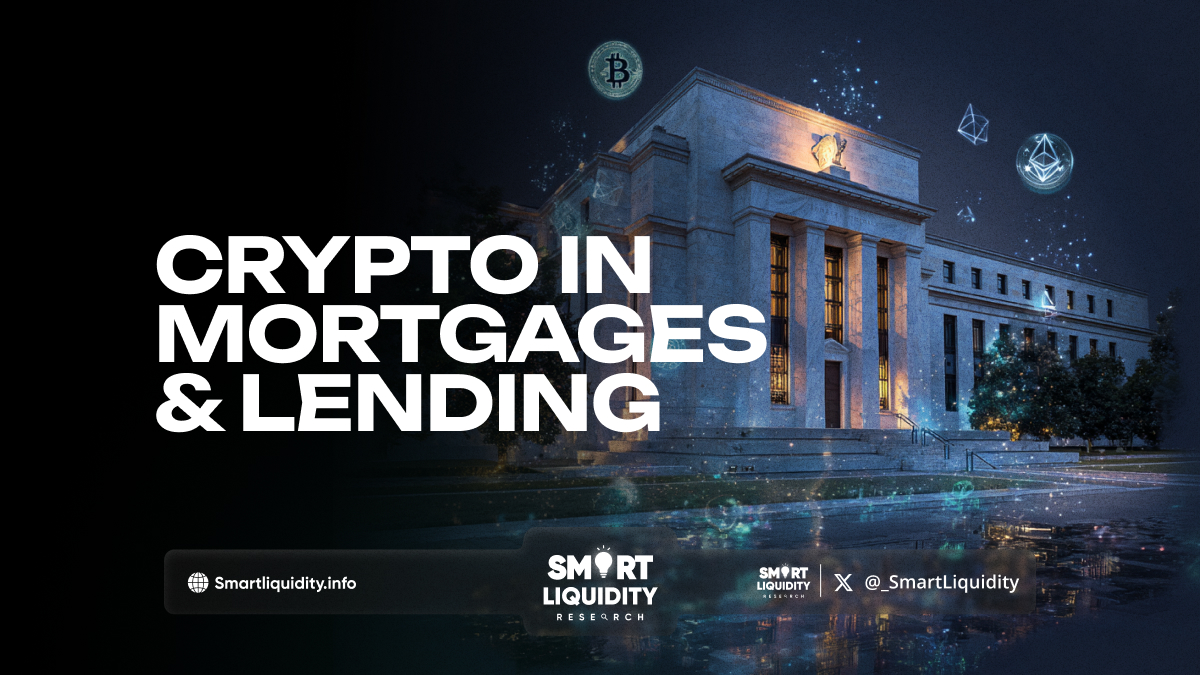Crypto in Mortgages & Lending


Cryptocurrencies are transforming real estate, particularly mortgages and lending. With blockchain-based home loans and decentralized platforms, crypto is merging with traditional finance to change borrowing, lending, and property ownership. This shift promises faster, borderless, and more inclusive services, especially in underserved areas.
The Evolution of Lending: From Banks to Blockchains
For decades, mortgage lending has been dominated by centralized financial institutions such as banks, credit unions, and mortgage companies. These lenders assess credit scores, income, and documentation before granting loans, a process that can take weeks or even months. The bureaucracy and tight regulations involved often exclude large segments of the population, including freelancers, immigrants, and crypto-native individuals.
Crypto lending challenges this model by introducing decentralized, automated, and collateral-based borrowing. Platforms like Aave, Compound, and MakerDAO allow users to deposit crypto as collateral and borrow stablecoins or other tokens. These smart contract-based systems cut out the middlemen, lower operational costs, and grant borrowers access to global liquidity pools without requiring traditional credit checks.
As blockchain-based protocols evolve, they are expanding into more sophisticated lending models—now including real-world assets like property.
Traditional vs Crypto Lending
Factor | Traditional Lending | Crypto Lending |
Speed | Slow (1–3 weeks) | Fast (minutes to days) |
Accessibility | Based on location & credit history | Global, permissionless |
Collateral Type | Real estate, income-based | Crypto assets, tokenized property |
Liquidity | Moderate | Varies, often low for tokenized real estate |
Regulation | Well-established | Emerging and fragmented |
Innovation Potential | Low | High (DeFi, NFTs, smart contracts, tokenization) |
Crypto-Backed Mortgages: How They Work
One of the most intriguing applications of crypto in lending is the crypto-backed mortgage. Instead of selling crypto to buy a house, individuals can leverage their digital assets to secure a fiat-denominated mortgage. This structure allows them to retain exposure to potential future gains in crypto while accessing traditional property markets.
Let’s examine the key differences between conventional mortgages and crypto-backed alternatives:
Component | Traditional Mortgage | Crypto-Backed Mortgage |
Collateral | Physical property | Digital assets (BTC, ETH, etc.) |
Lender Type | Banks, credit unions | CeFi platforms (e.g., Milo) or DeFi protocols |
Underwriting Criteria | Credit history, income, debt ratio | Primarily value of crypto collateral |
Approval Time | Weeks to months | 24 hours to a few days |
Repayment Terms | Fixed monthly payments in fiat | Flexible, may include stablecoins or crypto options |
Risk of Liquidation | Low | High, due to crypto volatility |
The loan-to-value (LTV) ratio for crypto-backed mortgages is typically conservative—often around 50% or lower—due to price volatility. Borrowers must be cautious, as a steep market downturn can lead to a margin call or forced liquidation of their collateral.
Use Cases: Real Estate Meets DeFi
The intersection of real estate and crypto lending isn’t just theoretical—it’s already being deployed across several real-world scenarios. Here are three notable use cases demonstrating this evolution:
Tokenized Real Estate and Fractional Ownership
Projects like RealT, Lofty AI, and Arrived Homes tokenize real estate into digital assets, typically structured as ERC-20 or NFT tokens. These platforms allow users to:
- Buy fractional shares of rental properties.
- Receive rental income via stablecoins like USDC.
- Trade ownership tokens on secondary markets.
This approach makes real estate investing more accessible by reducing capital barriers, enabling individuals to invest with as little as $50–$100.
CeFi Crypto Mortgage Lenders
Some centralized platforms bridge crypto with traditional mortgages:
- Milo: Offers 30-year U.S. home loans backed by crypto, targeting international crypto investors who lack U.S. credit histories.
- Figure: Uses its proprietary Provenance blockchain to streamline everything from loan origination to servicing and securitization.
These firms operate under regulatory compliance, offering familiarity to traditional borrowers while integrating digital assets.
Global Lending Access
Crypto lending democratizes financial access for users in countries with underdeveloped credit systems. Through DeFi protocols, individuals in emerging markets can borrow stablecoins using their crypto holdings without geographic or political barriers. It’s a powerful tool for economic inclusion.
Risks and Challenges of Crypto Lending
Despite the promise, the crypto-lending space also faces significant hurdles. Understanding these risks is crucial for both borrowers and lenders:
Volatility and Liquidation Risk
Crypto markets are notoriously volatile. A sudden drop in asset value can trigger a liquidation event, where the borrower’s collateral is automatically sold to maintain the lender’s safety. This risk requires constant monitoring and sometimes overcollateralization by up to 200%.
Regulatory Uncertainty
Lack of clear regulatory frameworks can limit adoption and pose legal risks. For example, crypto mortgages may fall into gray zones regarding securities laws, tax treatment, and consumer protections.
Smart Contract Risks
Decentralized lending protocols rely on smart contracts. If poorly written or audited, these contracts can be exploited by hackers. Past incidents, like the bZx and Cream Finance exploits, underline the importance of security.
Illiquidity of Tokenized Assets
While tokenization improves accessibility, it doesn’t always guarantee liquidity. If there’s insufficient demand for a tokenized real estate asset, holders may struggle to exit their positions or sell at market value.
Credit Scores, RWA, and Mortgage Markets on Chain
Looking ahead, the convergence of crypto and mortgages is likely to evolve in three key directions:
Blockchain-Based Credit Scores
On-chain credit systems like Spectral, Arcx, and ReputationDAO are developing decentralized credit profiles based on wallet activity, repayment history, and staking behavior. These tools could enable undercollateralized loans, bringing DeFi closer to traditional lending models.
Real-World Asset (RWA) Integration
Protocols like Centrifuge, Goldfinch, and Maple Finance bridge the gap between digital and physical assets, allowing businesses and individuals to obtain loans collateralized by invoices, inventory, or property. RWA integration could make crypto lending truly scalable.
Securitized Mortgage Markets on Chain
Imagine mortgage-backed securities issued as tokenized debt instruments on the blockchain. This would allow global investors to buy into mortgage pools with full transparency, programmable interest payments, and near-instant settlement. Companies like Figure are actively experimenting with this model.
Conclusion
The integration of crypto into mortgages and lending is reshaping finance from the ground up. While still in its early stages, this evolution opens new doors for global borrowers, crypto holders, and real estate investors. Faster approvals, borderless lending, fractional ownership, and the ability to collateralize crypto assets are just the beginning.
Nevertheless, adoption will depend on regulatory clarity, user education, improved security, and real-world use cases. As infrastructure matures and risks are mitigated, the dream of using your digital wallet to secure a home—or fund a property-backed investment—may soon become a mainstream reality.




